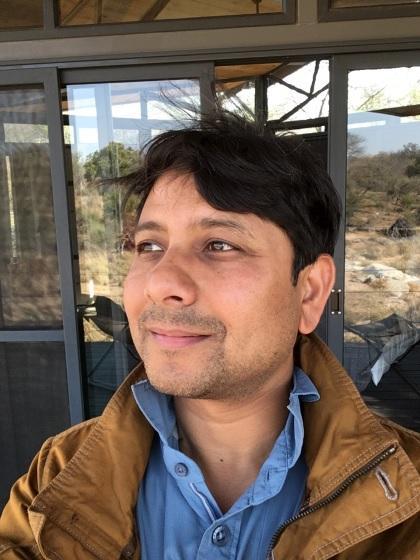Super sensors as possible outputs of a quantum gravity experiment
Last year, Anupam Mazumdar, a physicist from the University of Groningen, jointly proposed an experiment together with colleagues from the UK that could conclusively prove whether gravity is a quantum phenomenon. This experiment would focus on observing two relatively large, entangled quantum systems in free fall. In a new article, published on 4 June in Physical Review Research, the scientists describe in more detail how two types of noise could be reduced. They suggest that quantum interference could be applied in the production of a sensitive instrument that could detect movements of objects ranging from butterflies to burglars and black holes.
Is gravity a quantum phenomenon? That is one of the major outstanding questions in physics. Last year, together with colleagues, Assistant Professor of Theoretical Physics at the University of Groningen Anupam Mazumdar jointly proposed an experiment that could settle this question. Central to this experiment is a minuscule diamond, just a few nanometres in size, in which one of the carbon atoms has been replaced by a nitrogen atom. According to quantum physics, the extra electron in this atom would either absorb or not absorb the photon energy of a laser.
Diamond
Absorption of the energy would alter the electron’s spin value, a magnetic moment that can be either up or down. ‘Just like Schrödinger’s cat, which is dead and alive at the same time, this electron spin does and does not absorb the photon energy, so its spin is both up and down’, Mazumdar explains. This process results in quantum superposition of the entire diamond. By applying a magnetic field, it is possible to separate the two quantum states. When these quantum states are brought together again by turning off the magnetic field, they will create an interference pattern.
Collision
Any moving mass will have an effect on this very sensitive quantum system. In their latest paper, Mazumdar and colleagues describe how these disturbances can be reduced. However, it is also apparent that this system could be used to detect moving masses. The first source of noise is the collision of gas with the experimental capsule in free fall. Even the impact of photons can create a disturbance. ‘Our calculations show that these effects are minimized by placing the experimental capsule inside a larger container, which creates a controlled environment’, Mazumdar explains. Inside such an outer container, this noise is negligible at a pressure of 10-6 Pascal, even at room temperature. Requirements for conditions within the experimental capsule are more stringent. Currently, the scientists estimate a required pressure of 10-15 Pascal at around 1 Kelvin. Given the current state of technology, this is not yet feasible, but Mazumdar expects it could well be possible within around 20 years.
Space debris
Moving objects, even as small as a butterfly, located near the experimental site constitute a second source of noise. Calculations reveal that this noise can also be mitigated relatively easily by limiting access to the experimental site. People should maintain a distance of at least 2 metres from the experimental site, and cars should maintain a minimum distance of 10 metres from the site. Passing planes at a distance of more than 60 metres from the experimental site would not pose a problem. All of these requirements can be accomplished easily.
Once the experiment is up and running, its scope could be extended beyond an investigation of quantum gravity, according to Mazumdar. ‘You could put it in a spacecraft, where it is in free fall all the time. Then, you could use it to detect incoming space debris. By using several systems, it would even be possible to get the trajectory of the debris’. Another option is to place such a system in the Kuiper belt, where it would sense the movement of our solar system in space. ‘And it could detect any nearby black holes’, Mazumdar adds.
Back on Earth, the quantum system would be capable of detecting tectonic movements and perhaps providing early warnings of earthquakes. And, of course, the quantum system’s sensitivity to any movement occurring in proximity to it would make it an ideal, if somewhat complex, movement sensor and burglar alarm. But for now, the focus over the next few decades is on determining whether gravity is a quantum phenomenon.
Simple Science Summary
For decades, physicists have been working on a single theory that encompasses all four major forces in physics. Quantum theory unifies three of these forces but does not appear to accommodate the fourth, namely gravity. A group of physicists, including Anupam Mazumdar from the University of Groningen, recently proposed an experiment involving observations of two minuscule diamonds in free fall, which could prove whether or not gravity is a quantum phenomenon. This experimental system would also be highly sensitive to even the smallest of disturbances. In a new article, Mazumdar and colleagues show that locating the experiment within a vacuum container removes the noise caused by colliding gas particles in the experiment. Moreover, restricting access to the experimental site takes care of the interference caused by moving masses, ranging from butterflies to passing cars. Furthermore, this sensitivity to moving objects implies that the experimental system could serve as a movement sensor, with applications that include predicting earthquakes by measuring tectonic movements.
###
Reference: Marko Toroš, Thomas W. van de Kamp, Ryan J. Marshman, M. S. Kim, Anupam Mazumdar, and Sougato Bose: Relative acceleration noise mitigation for nanocrystal matter-wave interferometry: Applications to entangling masses via quantum gravity. Phys. Rev. Research, 4 June 2021
Media Contact
Rene Fransen
[email protected]
Original Source
https:/
Related Journal Article
http://dx.





